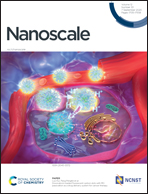A FRET-based upconversion nanoprobe assembled with an electrochromic chromophore for sensitive detection of hydrogen sulfide in vitro and in vivo†
Abstract
Hydrogen sulfide (H2S) as an important gaseous signaling molecule is closely related to numerous biological processes in living systems. To further study the physiological and pathological roles of H2S, convenient and efficient detection techniques for endogenous H2S in vivo are still in urgent demand. In this study, an electrochromic chromophore, dicationic 1,1,4,4-tetra-aryl butadiene (EM1), was innovatively introduced into upconversion nanoparticles (UCNPs) and a nanoprobe, PAAO–UCNPs–EM1, was constructed for the detection of H2S. This nanosystem was made of core–shell upconversion nanoparticles (NaYF4:Yb,Tm@NaYF4:Yb,Er), EM1, and polyacrylic acid (PAA)-octylamine. The EM1 with strong absorption ranging from 500 to 850 nm could serve as an energy acceptor to quench the upconversion luminescence of UCNPs through the Förster resonance energy transfer (FRET) process. In the presence of H2S, the EM1 in the nanoprobe was reduced to a colorless diene (EM2), resulting in the linear enhancement of luminescence emissions at 660 nm and 800 nm under the excitation of 980 nm light because the FRET was switched off. The nanoprobe PAAO–UCNPs–EM1PAAO–UCNPs–EM1 exhibited fast response and high sensitivity to H2S with a LoD of 1.21 × 10−7 M. Moreover, it was successfully employed in detecting the endogenous and exogenous H2S in living cells with high selectivity and low cytotoxicity. Also, this nanoprobe could distinguish normal and tumor cells by an upconversion luminescence imaging of endogenous H2S. Furthermore, the nanoprobe could significantly monitor H2S in a tumor-bearing nude mouse model. Therefore, we anticipate that this novel nanoprobe assembled with an electrochromic chromophore for responding to H2S and for bioimaging this molecule would have a promising prospect in biological and clinical investigations.



 Please wait while we load your content...
Please wait while we load your content...